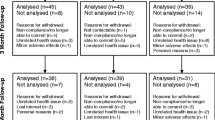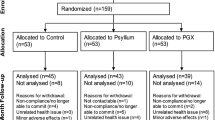Summary
Background
Fibrerich bread and cereals are included in the recommendations of a healthy diet.
Objective
To measure the effects of long–term consumption of the recommended intake of fibre–rich wheat bread on the iron status of young healthy women with adequate iron stores.
Design
Four–months intervention study including healthy female subjects assigned into two groups provided daily with 300 g of fibre–rich wheat bread, prepared with or without phytase as a supplement to their habitual diet.
Subjects
Forty–one women aged 24.8 ± 3.8 years (mean ± SD) and an average BMI of 22.0 ± 2.9 kg/m2 participated. Baseline values for serum ferritin were 45 µg/L, 22–83 (geometric mean, range) and for haemoglobin 132 g/L, 119–148 (arithmetic mean, range), respectively.
Results
Distribution of energy intake from protein, fat and carbohydrate, and daily intake of dietary fibre and iron were similar in the two groups and within the recommended levels. There was no effect of the phytase added to the wheat bread on the iron status of the subjects, but an effect of the intervention period. Serum ferritin and haemoglobin levels were significantly reduced by 12 ± 1.1 µg/L (27%) (P < 0.001) and 2 ± 0.8 g/l (1.5%) (mean ± SE) (P < 0.05) respectively, after four months of intervention.
Conclusions
The present long–term study indicates that consumption of the recommended daily intake of fibre–rich wheat bread results in an impairment of iron status in women with initially sufficient iron stores. Reduction of the phytic acid concentration in the bread was not sufficient to maintain iron status.
Similar content being viewed by others
Abbreviations
- NNR:
-
Nordic Nutrition Recommendations
- PTU:
-
Phytase unit
- IP6 :
-
Inositol hexaphosphates
- IP5 :
-
Inositol pentaphosphates
- IP4 :
-
Inositol tetraphosphates
- IP3 :
-
Inositol triphosphates
References
Slavin JL, Jacobs D, Marquart L, Wiemer K (2001) The role of whole grains in disease prevention. J Am Diet Assoc 101:780–785
Jacobs DR, Pereira MA, Meyer KA, Kushi LH (2000) Fiber from whole grains, but not refined grains, is inversely associated with all-cause mortality in older women: the Iowa women’s health study. J Am Coll Nutr 19:326S–330S
Kushi LH, Meyer KA, Jacobs DR Jr (1999) Cereals, legumes, and chronic disease risk reduction: evidence from epidemiologic studies. Am J Clin Nutr 70:451S–458S
Sandström B, Aro A, Becker W, Lyhne N, Pedersen J, Tórsdóttir (1996) Nordiska näringsrekommendationer 1996 (Nordic Nutrient Recommendations 1996). Nordisk Ministerråd, Copenhagen
Danish Veterinary and Food Administration (1997) Mad med mange kulhydrater (Diets high in carbohydrates).ID 1997211, ISBN 87-601-1969-1
Dietary Guidelines for Americans (2000) United States Department of Agriculture, United States Department of Health and Human Services
WHO (1992) The prevalence of anaemia in women. WHO/MCH/MSM, 2nd ed
ACC/SCN (2000) Fourth report on the World Nutrition Situation, Nutrition throughout the life cycle. World Health Organization (WHO), Administrative Committee on Coordination (ACC), Sub-Committee on Nutrition (SCN), International Food policy Research Institute (IFPRI), 4. Geneva
Milman N, Byg KE, Ovesen L, Kirchhoff M, Jurgensen KS (2003) Iron status in Danish women, 1984–1994: a cohort comparison of changes in iron stores and the prevalence of iron deficiency and iron overload. Eur J Haematol 71:51–61
Milman N, Byg KE, Ovesen L, Kirchhoff M, Jurgensen KS (2002) Iron status in Danish men 1984–1994: a cohort comparison of changes in iron stores and the prevalence of iron deficiency and iron overload. Eur J Haematol 68:332–340
Jiang R, Manson JE, Meigs JB, Ma J, Rifai N, Hu FB (2004) Body iron stores in relation to risk of type 2 diabetes in apparently healthy women. JAMA 291:711–717
Wolff B, Volzke H, Ludemann J, Robinson D, Vogelgesang D, Staudt A, Kessler C, Dahm JB, John U, Felix SB (2004) Association between high serum ferritin levels and carotid atherosclerosis in the study of health in Pomerania (SHIP). Stroke 35:453–457
Milman N, Kirchhoff M, Jorgensen T (1992) Iron status markers, serum ferritin and hemoglobin in 1359 Danish women in relation to menstruation, hormonal contraception, parity, and postmenopausal hormone treatment. Ann Hematol 65:96–102
Milman N, Clausen JO, Jordal R (1995) Iron status in young Danish men and women: a population survey comprising 548 individuals. Ann Hematol 70:215–221
Sandberg A-S, Carlsson N-G, Svanberg U (1989) Effects of Inositol Tri-, Tetra-, Penta-, and Hexaphosphates in In Vitro Estimation of Iron Availability. J Food Sci 54:159–161
Hallberg L, Rossander L, Skanberg AB (1987) Phytates and the inhibitory effect of bran on iron absorption in man. Am J Clin Nutr 45:988–996
Hallberg L, Brune M, Rossander L (1989) Iron absorption in man: ascorbic acid and dose-dependent inhibition by phytate. Am J Clin Nutr 49:140–144
Reddy MB, Hurrell RF, Cook JD (2000) Estimation of nonheme-iron bioavailability from meal composition. Am J Clin Nutr 71:937–943
Baech SB, Hansen M, Bukhave K, Jensen M, Sorensen SS, Kristensen L, Purslow PP, Skibsted LH, Sandstrom B (2003) Nonheme-iron absorption from a phytate-rich meal is increased by the addition of small amounts of pork meat. Am J Clin Nutr 77:173–179
Hurrell RF, Reddy MB, Juillerat MA, Cook JD (2003) Degradation of phytic acid in cereal porridges improves iron absorption by human subjects. Am J Clin Nutr 77:1213–1219
Cook JD, Dassenko SA, Lynch SR (1991) Assessment of the role of nonhemeiron availability in iron balance. Am J Clin Nutr 54:717–722
Cook JD, Reddy MB (2001) Effect of ascorbic acid intake on nonheme-iron absorption from a complete diet. Am J Clin Nutr 73:93–98
Lind T, Lonnerdal B, Persson LA, Stenlund H, Tennefors C, Hernell O (2003) Effects of weaning cereals with different phytate contents on hemoglobin, iron stores, and serum zinc: a randomized intervention in infants from 6 to 12 mo of age. Am J Clin Nutr 78:168–175
Lopez HW, Duclos V, Coudray C, Krespine V, Feillet-Coudray C, Messager A, Demigne C, Remesy C (2003) Making bread with sourdough improves mineral bioavailability from reconstituted whole wheat flour in rats. Nutrition 19:524–530
Sandberg AS, Ahderinne R (1986) Hplc Method for Determination of Inositol Triphosphates, Tetraphosphates, Pentaphosphates and Hexaphosphates in Foods and Intestinal Contents. J Food Sci 51:547–550
Sandström B (1993) Impaired iron status in young healthy subjects after a dietary change to a high fiber diet. Bioavailability ’93. Nutritional, chemical and food processing implications of nutrient availability.Proceedings part I, pp 159–163
Hallberg L, Rossander-Hultén L (1991) Iron requirements in menstruating women. Am J Clin Nutr 54:1047–1058
Turk M, Carlsson NG, Sandberg AS (1996) Reduction in the levels of phytate during wholemeal bread making; Effect of yeast and wheat phytases. J Cereal Sci 23:257–264
Marquart L, Wiemer KL, Jones JM, Jacob B (2003) Whole grains health claims in the USA and other efforts to increase whole-grain consumption. Proc Nutr Soc 62:151–160
Milman N, Pedersen NS, Visfeldt J (1983) Serum ferritin in healthy Danes: relation to marrow haemosiderin iron stores. Dan Med Bull 30:115–120
Author information
Authors and Affiliations
Corresponding author
Additional information
Contributors: ABAJ, ADT, BS and MH co–developed the study design. ABAJ was involved in the subject recruitment and data collection under the supervision of MH. All authors were involved in the interpretation of the results. MBK, IT and MH wrote the first draft. MBK and IT co–refined it into the final draft after contributions from all authors.
Rights and permissions
About this article
Cite this article
Bach Kristensen, M., Tetens, I., Alstrup Jørgensen, A.B. et al. A decrease in iron status in young healthy women after long–term daily consumption of the recommended intake of fibre–rich wheat bread. Eur J Nutr 44, 334–340 (2005). https://doi.org/10.1007/s00394-004-0529-4
Received:
Accepted:
Published:
Issue Date:
DOI: https://doi.org/10.1007/s00394-004-0529-4




